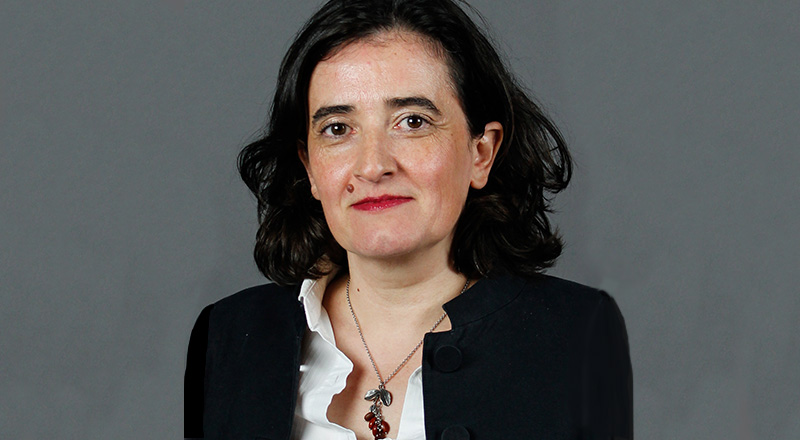Catherine Dubourdieu receives ERC Advanced Grant

Catherine Dubourdieu: The physicist and materials scientist receives the ERC Advanced Grant of 2.5 million euros over five years for her project LUCIOLE. © Materials Research Society USA
Prof. Dr. Catherine Dubourdieu heads the Institute “Functional Oxides for Energy-Efficient Information Technology” at HZB and is Professor at the Physical and Theoretical Chemistry division at Freie Universität Berlin. The physicist and materials scientist specialises in nanometre-sized functional oxides and their applications in information technologies. She has now been awarded a prestigious ERC Advanced Grant for her research project “LUCIOLE”, which aims at combining ferroelectric polar textures with conventional silicon technologies.
With its ERC Advanced Grant format, the European Research Council enables outstanding scientists to conduct pioneering and groundbreaking high-risk research. An ERC Advanced Grant is considered one of the highest awards for experienced researchers.
The project LUCIOLE focuses on ferroelectric nanometer-size oxides, which can host exotic polar textures such as vortices or skyrmions. With a wealth of potential emergent properties, whirling topological polar nanodomains could lead to novel devices, for example ultra-compact memories that store more than a terabyte per square inch. “We want to pave the way to future low power nanoelectronics based on topological defects” says Catherine Dubourdieu.
Monolithically integrated polar textures on silicon will be created and investigated on a nanoscale with state-of-the-art microscopy and spectroscopy techniques. These engineered polarization patterns will be embedded into ultra-scaled devices to study their manipulation and dynamics under electric field.
"We have known about the phenomenon of ferroelectricity for a good hundred years. But it is only in recent years that exotic polar textures have been unveiled. This opens up exciting possibilities for revolutionary new materials and devices. This is definitely the best time to be at the forefront of this field of research," says Dubourdieu.
LUCIOLE: Layering, Understanding, Controlling and Integrating Ferroelectric Polar Textures on Silicon.
News from the ERC
With ERC Grants, the European Research Council supports outstanding scientists who want to implement risky but potentially groundbreaking research ideas. An ERC Advanced Grant is considered one of the highest awards for experienced researchers.
arö
https://www.helmholtz-berlin.de/pubbin/news_seite?nid=24759;sprache=en
- Copy link
-
Peat as a sustainable precursor for fuel cell catalyst materials
Iron-nitrogen-carbon catalysts have the potential to replace the more expensive platinum catalysts currently used in fuel cells. This is shown by a study conducted by researchers from the Helmholtz-Zentrum Berlin (HZB), Physikalisch-Technische Bundesanstalt (PTB) and universities in Tartu and Tallinn, Estonia. At BESSY II, the team observed the formation of complex microstructures within various samples. They then analysed which structural parameters were particularly important for fostering the preferred electrochemical reactions. The raw material for such catalysts is well decomposed peat.
-
Helmholtz Investigator Group on magnons
Dr Hebatalla Elnaggar is setting up a new Helmholtz Investigator Group at HZB. At BESSY II, the materials scientist will investigate so-called magnons in magnetic perovskite thin films. The aim is to lay the foundations for future terahertz magnon technology: magnonic devices operating in the terahertz range could process data using a fraction of the energy required by the most advanced semiconductor devices, and at speeds up to a thousand times faster.
-
The future of corals – what X-rays can tell us
This summer, it was all over the media. Driven by the climate crisis, the oceans have now also passed a critical point, the absorption of CO
2 is making the oceans increasingly acidic. The shells of certain sea snails are already showing the first signs of damage. But also the skeleton structures of coral reefs are deteriorating in more acidic conditions. This is especially concerning given that corals are already suffering from marine heatwaves and pollution, which are leading to bleaching and finally to the death of entire reefs worldwide. But how exactly does ocean acidification affect reef structures?
Prof. Dr. Tali Mass, a marine biologist from the University of Haifa, Israel, is an expert on stony corals. Together with Prof. Dr. Paul Zaslansky, X-ray imaging expert from Charité Berlin, she investigated at BESSY II the skeleton formation in baby corals, raised under different pH conditions. Antonia Rötger spoke online with the two experts about the results of their recent study and the future of coral reefs.
